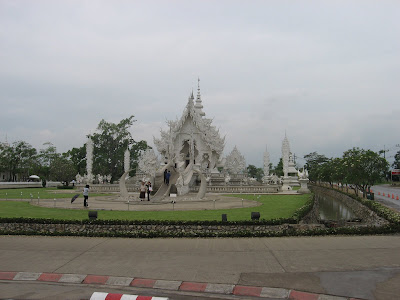Well, how could we not? We were so close to the infamous "Golden Triangle" that we just had to visit.
The Golden Triangle is where the Mae Sai River meets the Mekong River, and the countries of Thailand, Myanmar, and Laos touch and is situated on the banks of the mighty Mekong river (now almost reduced to half it's previous size by the building upstream of hydro-electric dams by the Chinese government.
The Chinese finished their first dam, Manwan, in 1996 and the second at Dachaoshan in October 2002 and the problem is due to worsen.
Six more dams are planned in Yunnan province. The next, being built at Xiaowan and due for completion in 2012, will be only slightly smaller than the Three Gorges dam on the Yangtze, with a reservoir stretching back 105 miles.
Our first stop was at Sop Ruak. Sop Ruak's most enjoyable tourist pastime is its boat tours. Longtail boats are available for hire here, and cruise up and down the Mekong River allowing visitors a glimpse of village life in the many riverside settlements on both sides of the border. We didn't have time to go on the boat trip, so we settled for a sumptuous luncheon and walking tour around the town.
Gambling and in particular casino's are illegal in Thailand. On the Myanmar side of the border there is a casino which has proved itself to be very popular with Thai's.
One of the world's supreme rivers, the Mekong runs for 3,000 miles through dramatically changing scenery, from the glaciers of Tibet, through the mountains of southern China and the plains of Burma, Thailand, Laos, Cambodia and Vietnam, before emptying into the South China Sea.
We left Sop Ruak and journeyed on to Mae Sai, the Thai border town lying on the border between Thailand and Myanmar. Crossing over the border into the Burmese town of Taichilek and back again allows visitors to renew their 30-day visa to continue their stay in Thailand.
There is a massive market at Mai Sai and as is our custom, we just had to spend an hour to hone our haggling skills and perhaps pick-up another bargain or two. Russell got several.
After Mai Sai, it was time to head home. As we traveled from Mai Sai toward Chiang-Mai, we passed through several police check points where they would stop vehicles and conduct a search for illegal immigrants and drugs.
A last stop before arriving at Chiang-Mai was the "Cabbages and Condoms Resort". This turned out to be a surreal experience as whenever you purchased something, coffee, chocolate, etc. You would be handed a free condom along with your change!
The toilets of the Cabbages and Condoms Resort had this intriguing sign in them:
Some five hours after leaving Mai Sai, we arrived back at our hotel at Chiang-Mai. A great day and a fantastic experience, although next trip we will leave more time for our visit to Northern Thailand. A single day just can't do it justice.








































